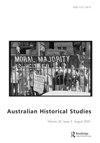珊瑚海文化互动圈:跨越珊瑚海的联系:一个运动的故事,昆士兰博物馆,2022年8月18日至2023年7月9日
IF 0.6
3区 历史学
Q1 HISTORY
引用次数: 0
摘要
“珊瑚海的连接”展览是由昆士兰博物馆和澳大利亚研究委员会澳大利亚生物多样性和遗产卓越中心合作举办的。展出的是珊瑚海周围和整个珊瑚海的文化运动和互动的故事。这个地区的人类历史与Sahul(澳大利亚和新几内亚)的居住地一样悠久:65000年。新几内亚群岛在4万到3万年前就有人定居了,而托雷斯海峡的一座陆桥直到8000年前才消失。最近的从亚洲到西太平洋的迁徙发生在3500到2500年前。这些移民说南岛语,并发展了“拉皮塔”陶器。这次展览利用最近的研究和昆士兰博物馆的优秀藏品,揭示了跨越珊瑚海的古代双向文化运动。它以托雷斯海峡群岛和北昆士兰的丁加尔和恩古鲁蒙古民族为特色。在太平洋和澳大利亚的定居过程中,有许多未知因素,尤其是早期、晚期和后拉皮塔运动。史前学家在萨胡尔的南北之间几乎没有发现任何联系。早期对拉皮塔移民的研究表明,他们避开了新几内亚的内陆,沿着北海岸前进,在俾斯麦群岛游荡了一千年,然后跨越了所罗门群岛的大部分地区,在圣克鲁斯群岛和瓦努阿图定居,然后继续进入遥远的大洋洲。昆士兰博物馆的展览涉及珊瑚海周围的联系,对澳大利亚和太平洋的历史产生了影响,史前学家已经知道了十年,但公众,甚至我怀疑大多数现代历史学家都不知道。独木舟本文章由计算机程序翻译,如有差异,请以英文原文为准。
The Coral Sea Cultural Interaction Sphere: Connections across the Coral Sea: A Story of Movement, Queensland Museum, 18 August 2022–9 July 2023
The exhibition Connections across the Coral Sea is a partnership between Queens-land Museum and the Australian Research Council Centre of Excellence for Australian Biodiversity and Heritage. On display is the story of cultural movement and interaction around and across the Coral Sea. It is an area with a human time-depth as old as the habitation of Sahul (Australia and New Guinea): 65,000 years. The archipelagos off New Guinea were settled 40,000 – 30,000 years ago, and a land bridge remained at Torres Strait until 8,000 years ago. More recent movements out of Asia and into the Western Paci fi c occurred between 3,500 and 2,500 years ago. These migrants spoke Austronesian languages and developed ‘ Lapita ’ pottery. The exhibition uses recent research and the Queensland Museum ’ s excellent collection to uncover ancient two-way cultural movements across the Coral Sea. It features the Torres Strait Islands and the Dingaal and Ngurrumungu nations from North Queensland. There are many unknowns in the settlement of the Paci fi c and Australia, not least the early, late and post-Lapita movements. Prehistorians have found few connections between the north and south of Sahul. Earlier research on the Lapita migrants suggested they avoided the underbelly of New Guinea, working their way along the north coast, loitering for a thousand years in the Bismarck Archipelago, then leapfrogging over most of the Solomon Islands, settling in the Santa Cruz group and Vanuatu, before continuing into Remote Oceania. The Queensland Museum exhibition deals with connections around the Coral Sea, raising implications for Australian and Paci fi c history, which have been known to prehistorians for a decade, but not by the public or even, I suspect, most modern historians. Canoes
求助全文
通过发布文献求助,成功后即可免费获取论文全文。
去求助
来源期刊

AUSTRALIAN HISTORICAL STUDIES
HISTORY-
CiteScore
0.70
自引率
16.70%
发文量
86
期刊介绍:
Australian Historical Studies is a refereed journal dealing with Australian, New Zealand and Pacific regional issues. The journal is concerned with aspects of the Australian past in all its forms: heritage and conservation, archaeology, visual display in museums and galleries, oral history, family history, and histories of place. It is published in March, June and September each year.
 求助内容:
求助内容: 应助结果提醒方式:
应助结果提醒方式:


